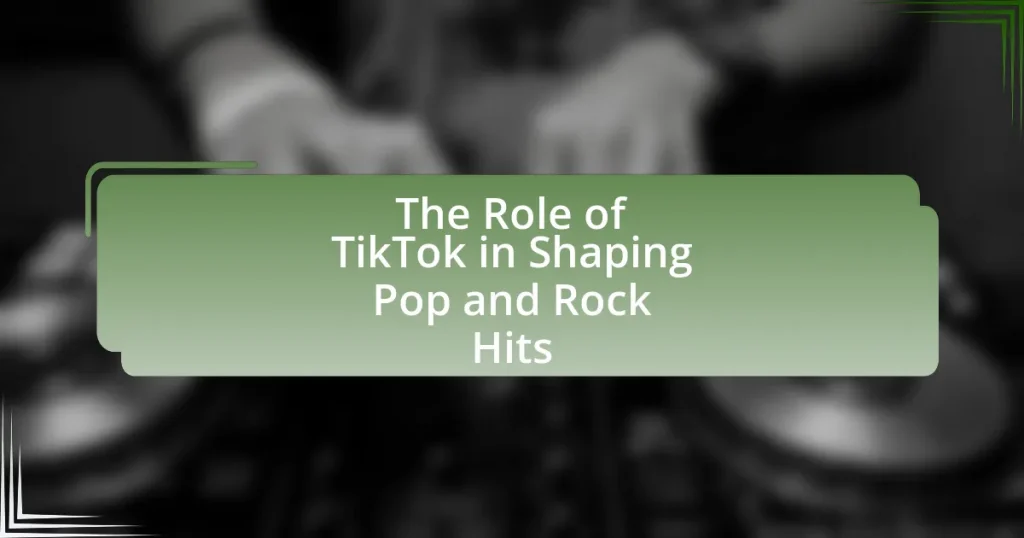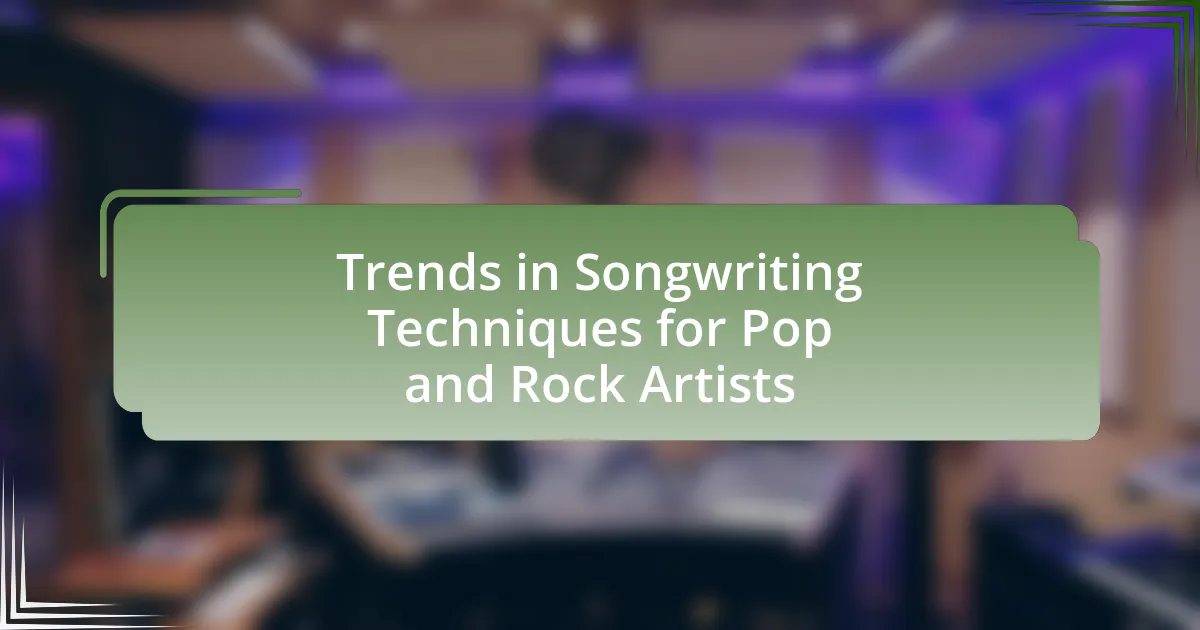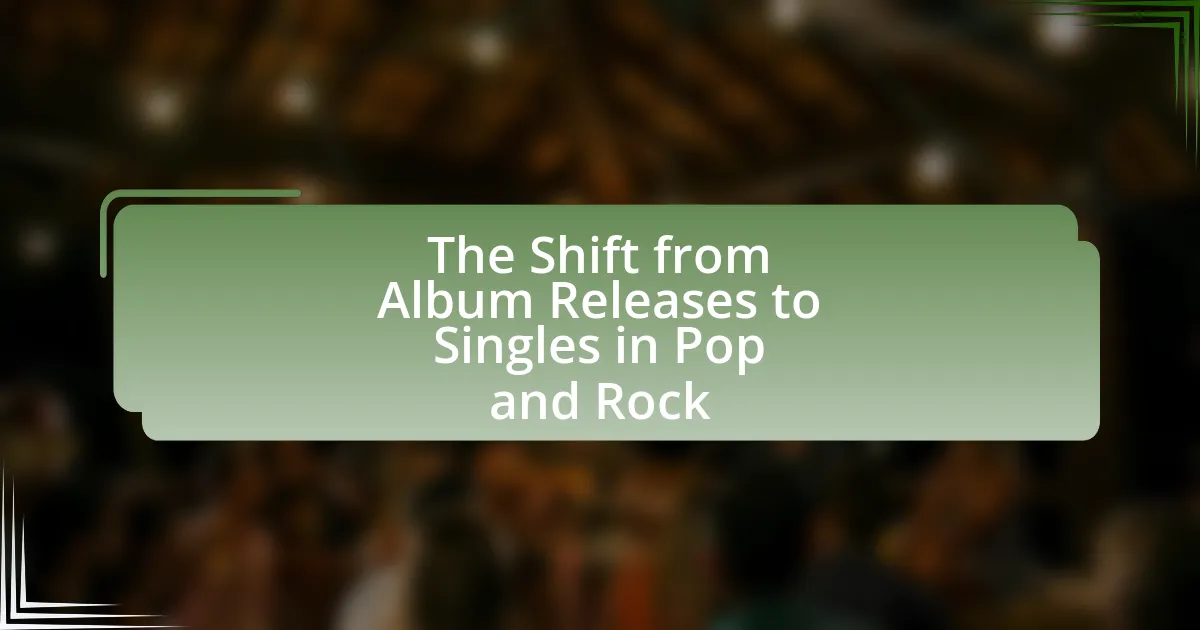TikTok plays a pivotal role in shaping pop and rock hits by facilitating music discovery and viral trends through its algorithm-driven platform. The app promotes short, engaging clips that often feature song snippets, leading to increased streaming and chart success for tracks like “Savage Love” and “Old Town Road.” TikTok’s unique features, such as user-generated content and trending challenges, allow emerging artists to gain visibility and connect directly with audiences, fundamentally transforming music marketing and consumption. The article explores how TikTok influences music trends, the characteristics of successful TikTok-driven hits, and the implications for artists and the music industry as a whole.
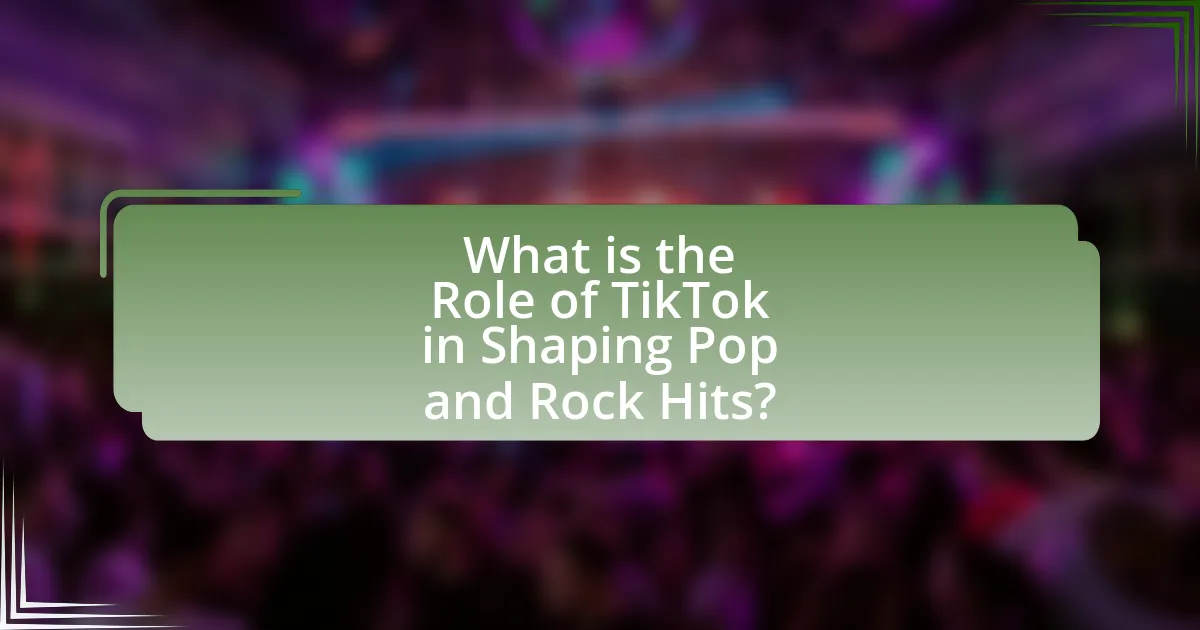
What is the Role of TikTok in Shaping Pop and Rock Hits?
TikTok plays a significant role in shaping pop and rock hits by serving as a platform for music discovery and viral trends. The app’s algorithm promotes short, engaging clips that often feature snippets of songs, leading to increased streams and chart performance. For instance, songs like “Savage Love” by Jawsh 685 and Jason Derulo gained popularity primarily through TikTok challenges, resulting in the song reaching number one on the Billboard Hot 100. Additionally, the platform allows artists to connect directly with audiences, fostering a community that can propel tracks to mainstream success. This dynamic has transformed how music is marketed and consumed, making TikTok a crucial player in the contemporary music landscape.
How has TikTok influenced music trends in pop and rock genres?
TikTok has significantly influenced music trends in pop and rock genres by serving as a platform for viral challenges and snippets that propel songs into mainstream popularity. The app’s algorithm promotes catchy hooks and engaging content, leading to songs like “Old Town Road” by Lil Nas X achieving record-breaking success after going viral on the platform. Additionally, TikTok’s user-generated content allows emerging artists to gain exposure, as seen with Olivia Rodrigo, whose song “drivers license” gained traction through TikTok before its official release. This trend demonstrates how TikTok acts as a catalyst for music discovery and consumption, reshaping how audiences engage with pop and rock music.
What specific features of TikTok contribute to music discovery?
TikTok’s algorithm-driven For You Page is a primary feature that contributes to music discovery by curating personalized content based on user interactions. This algorithm analyzes user behavior, such as likes, shares, and watch time, to promote trending songs and emerging artists, making them more visible to a wider audience. Additionally, the platform’s short-form video format encourages users to create and share content using specific songs, leading to viral challenges and trends that further amplify music exposure. The integration of music licensing agreements allows users to access a vast library of songs, facilitating seamless incorporation into videos. These features collectively enhance music discovery, as evidenced by numerous songs gaining popularity and chart success after being featured in TikTok videos, such as “Savage Love” by Jawsh 685 and Jason Derulo, which became a global hit largely due to its viral TikTok presence.
How do TikTok challenges and trends impact song popularity?
TikTok challenges and trends significantly enhance song popularity by creating viral moments that drive user engagement and exposure. When a song is associated with a popular challenge, it often leads to increased streams and downloads, as users seek to participate in the trend. For instance, the song “Savage Love” by Jawsh 685 and Jason Derulo saw a 1,000% increase in streams after it became the soundtrack for a viral TikTok dance challenge. This phenomenon illustrates how TikTok serves as a powerful platform for music discovery, allowing songs to reach wider audiences rapidly.
Why is TikTok considered a powerful platform for emerging artists?
TikTok is considered a powerful platform for emerging artists because it offers unprecedented visibility and engagement opportunities. The platform’s algorithm promotes content based on user interaction rather than follower count, allowing new artists to reach large audiences quickly. For instance, songs that go viral on TikTok can lead to significant streaming increases; a study by the University of Southern California found that tracks featured in TikTok videos saw a 1,000% increase in streams on platforms like Spotify. This unique ability to create trends and drive music discovery makes TikTok an essential tool for artists looking to break into the music industry.
What success stories illustrate TikTok’s impact on new musicians?
TikTok has significantly impacted new musicians, with notable success stories such as Lil Nas X and Olivia Rodrigo. Lil Nas X gained fame with his song “Old Town Road,” which went viral on TikTok, leading to its chart-topping success and multiple Grammy nominations. Olivia Rodrigo’s “drivers license” similarly exploded on the platform, amassing over 100 million streams within a week of its release, showcasing TikTok’s ability to propel songs to mainstream success. These examples illustrate how TikTok serves as a powerful launchpad for emerging artists, enabling them to reach vast audiences quickly and effectively.
How does TikTok provide opportunities for viral marketing in music?
TikTok provides opportunities for viral marketing in music by leveraging its algorithm that promotes engaging content to a wide audience, allowing songs to gain rapid popularity. The platform’s short-form video format encourages users to create and share content featuring specific tracks, often leading to trends or challenges that can propel a song into mainstream success. For instance, songs like “Savage Love” by Jawsh 685 and Jason Derulo gained significant traction on TikTok, resulting in millions of user-generated videos and a surge in streaming numbers. This phenomenon illustrates how TikTok’s unique structure and user engagement can effectively amplify music marketing efforts, making it a powerful tool for artists and labels seeking viral exposure.
What role do algorithms play in promoting music on TikTok?
Algorithms on TikTok play a crucial role in promoting music by analyzing user interactions and preferences to curate personalized content feeds. These algorithms prioritize trending sounds and songs, amplifying their visibility based on factors such as engagement rates, shares, and user demographics. For instance, when a specific track gains traction through user-generated content, the algorithm boosts its reach, leading to increased plays and potential chart success. This data-driven approach has been shown to significantly influence music discovery, as evidenced by the rise of numerous songs that became hits after going viral on the platform, such as “Savage Love” by Jawsh 685 and Jason Derulo, which gained popularity through TikTok challenges.
How does TikTok’s algorithm determine which songs go viral?
TikTok’s algorithm determines which songs go viral by analyzing user engagement metrics such as likes, shares, comments, and the duration of video views. The algorithm prioritizes content that resonates with users, promoting songs that are frequently used in popular videos, thereby increasing their visibility. For instance, songs that are featured in trending challenges or memes often gain traction due to their association with high engagement rates, leading to a viral effect. This process is supported by TikTok’s machine learning models, which continuously adapt to user preferences and trending content, ensuring that songs with higher interaction levels are more likely to be promoted on the platform.
What factors influence the visibility of music content on TikTok?
The visibility of music content on TikTok is influenced by several key factors, including algorithmic recommendations, user engagement, and trending challenges. The TikTok algorithm prioritizes content that garners high engagement rates, such as likes, shares, and comments, which increases the likelihood of music tracks being featured on users’ “For You” pages. Additionally, participation in trending challenges or hashtags can significantly boost a song’s visibility, as users often seek out content related to popular trends. According to a study by the University of Southern California, songs that are part of viral challenges see a 50% increase in streaming numbers on platforms like Spotify, demonstrating the direct impact of TikTok’s ecosystem on music visibility.
How does TikTok connect artists with their audience?
TikTok connects artists with their audience primarily through its algorithm-driven content discovery, which promotes user-generated videos featuring music. This platform allows artists to share snippets of their songs, enabling users to create and share their own content, thereby increasing engagement and visibility. According to a report by the Recording Industry Association of America, TikTok has significantly influenced music consumption, with many songs gaining popularity through viral challenges and trends initiated by users. This interaction fosters a direct relationship between artists and fans, as audiences can engage with the music in a creative and participatory manner.
What are the implications of TikTok’s influence on traditional music marketing?
TikTok’s influence on traditional music marketing has significantly shifted promotional strategies and audience engagement. The platform’s algorithm promotes viral content, allowing songs to gain rapid popularity through user-generated videos, which contrasts with traditional marketing methods that rely on radio play and music videos. For instance, songs like “Savage Love” by Jawsh 685 and Jason Derulo gained mainstream success primarily due to TikTok trends, demonstrating how the platform can propel tracks to chart-topping status without conventional marketing efforts. This shift necessitates that record labels adapt their strategies to prioritize social media engagement and influencer partnerships, fundamentally altering the landscape of music promotion.
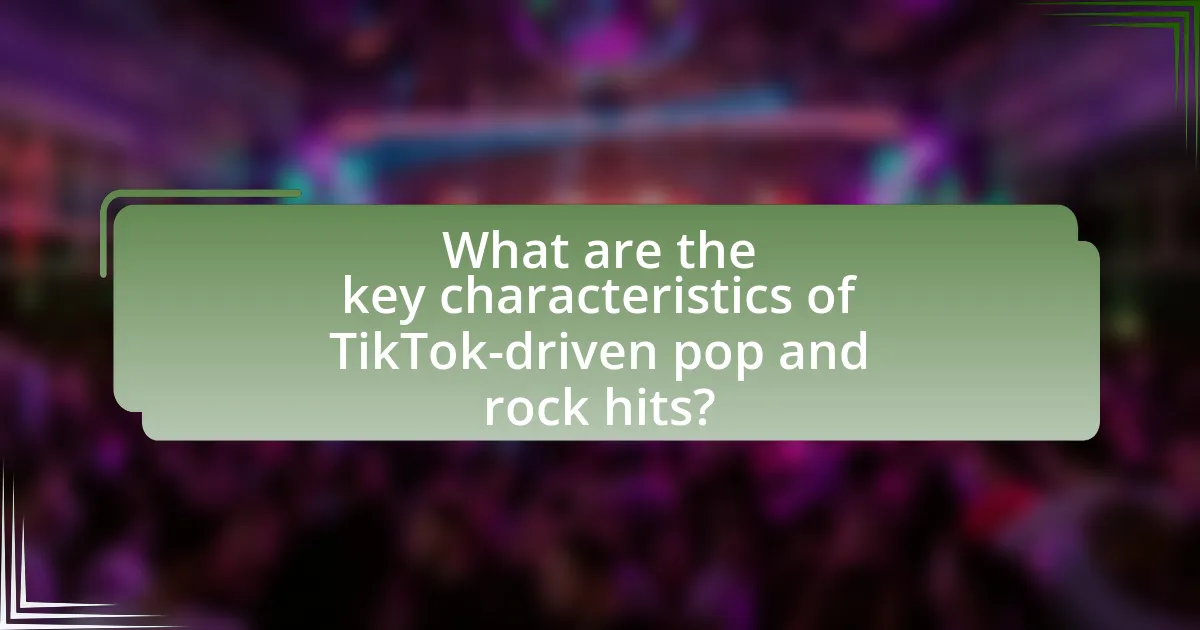
What are the key characteristics of TikTok-driven pop and rock hits?
TikTok-driven pop and rock hits are characterized by their catchy hooks, short durations, and viral dance challenges. These elements are designed to engage users quickly, as TikTok’s format favors brief, attention-grabbing content. The platform’s algorithm promotes songs that can easily be incorporated into user-generated content, leading to increased exposure and popularity. For instance, tracks like “Savage Love” by Jawsh 685 and Jason Derulo gained massive traction on TikTok due to their memorable choruses and the viral dance associated with them, demonstrating how the platform can propel songs to mainstream success.
What musical elements are commonly found in TikTok hits?
TikTok hits commonly feature catchy melodies, repetitive hooks, and strong rhythmic elements. These musical elements are designed to engage listeners quickly, as TikTok videos are often short and require immediate attention. The use of familiar chord progressions and upbeat tempos further enhances the appeal, making songs more likely to go viral. Additionally, many TikTok hits incorporate sound bites or samples from popular culture, which resonate with the platform’s user base and encourage user-generated content.
How do song length and structure adapt for TikTok’s format?
Songs for TikTok typically adapt to shorter lengths, often around 15 to 30 seconds, to fit the platform’s quick consumption style. This brevity encourages artists to create catchy hooks and memorable choruses that can engage users rapidly, as TikTok videos often rely on snippets of songs to accompany visual content. The structure of these songs frequently emphasizes a strong, immediate impact, with a focus on the most engaging parts of the track, such as the chorus or a standout instrumental section, to capture attention quickly. This adaptation is supported by the platform’s algorithm, which favors content that retains viewer engagement, leading to a trend where songs that perform well on TikTok can achieve significant streaming success across other platforms.
What genres are most frequently featured in TikTok trends?
The genres most frequently featured in TikTok trends are pop, hip-hop, and dance. These genres dominate the platform due to their catchy melodies and rhythmic beats, which encourage user engagement through challenges and dances. According to a report by the marketing agency, The Influencer Marketing Factory, pop music accounted for 40% of the top trending songs on TikTok in 2021, while hip-hop and dance genres followed closely, reflecting their popularity in user-generated content.
How do lyrics and themes resonate with TikTok users?
Lyrics and themes resonate with TikTok users by reflecting their emotions, experiences, and cultural trends, which enhances user engagement and content creation. TikTok’s algorithm promotes songs that evoke strong feelings or relatable narratives, leading to viral trends and challenges. For instance, songs like “Savage Love” by Jawsh 685 and Jason Derulo gained popularity on TikTok due to their catchy hooks and themes of love and relationships, resulting in millions of user-generated videos. This interaction between music and user expression demonstrates how TikTok serves as a platform for amplifying songs that connect deeply with its audience.
What topics are popular among TikTok music trends?
Popular topics among TikTok music trends include relatable life experiences, dance challenges, and nostalgic throwbacks. These themes resonate with users, driving engagement and virality. For instance, songs that evoke strong emotions or memories often trend, as seen with tracks like “Say So” by Doja Cat, which gained popularity through a viral dance challenge. Additionally, TikTok’s algorithm favors catchy hooks and short snippets, making upbeat and easily digestible songs more likely to trend. This pattern has been supported by data showing that tracks featured in TikTok videos often see significant increases in streaming numbers and chart performance.
How do artists tailor their lyrics for TikTok engagement?
Artists tailor their lyrics for TikTok engagement by creating catchy, relatable, and concise phrases that resonate with the platform’s short-form video format. This approach often includes using hooks that can easily be repeated or remixed, as well as incorporating trending themes or challenges that align with TikTok’s viral culture. For instance, songs like “Savage Love” by Jawsh 685 and Jason Derulo gained popularity due to their memorable hooks that users could easily incorporate into dance challenges or lip-sync videos. Additionally, artists often analyze TikTok trends and user-generated content to inform their songwriting, ensuring that their lyrics align with what is currently popular on the platform.
What production techniques are favored in TikTok music?
TikTok music production favors techniques such as catchy hooks, short song structures, and heavy use of digital effects. These techniques are designed to capture attention quickly, as TikTok videos are typically brief, often lasting only 15 to 60 seconds. The emphasis on hooks ensures that the most memorable parts of a song are highlighted, making them more shareable and likely to go viral. Additionally, the use of digital effects, including pitch correction and vocal layering, enhances the overall sound quality and appeal of tracks, aligning with contemporary pop and rock trends. This approach has been validated by the success of numerous songs that gained popularity on the platform, demonstrating the effectiveness of these production techniques in engaging audiences.
How does the use of hooks and catchy melodies enhance TikTok appeal?
The use of hooks and catchy melodies significantly enhances TikTok’s appeal by creating memorable and engaging content that encourages user interaction. These musical elements capture attention quickly, which is essential in a platform where users scroll rapidly through videos. Research indicates that songs featuring strong hooks and catchy melodies are more likely to go viral, as they resonate with users and prompt them to create their own content, such as dance challenges or lip-syncs. For instance, a study by the University of Southern California found that songs with repetitive hooks are 30% more likely to be shared on social media platforms, including TikTok, thus amplifying their reach and popularity.
What role does collaboration play in creating TikTok-friendly music?
Collaboration is essential in creating TikTok-friendly music as it combines diverse artistic influences and expands audience reach. By working together, artists can blend different genres and styles, resulting in catchy hooks and relatable lyrics that resonate with TikTok users. For instance, collaborations often lead to viral challenges or trends, as seen with the song “Savage Love” by Jawsh 685 and Jason Derulo, which gained immense popularity on the platform. This synergy not only enhances the musical quality but also leverages the social media platform’s algorithm, increasing the chances of the song becoming a hit.
What are the challenges and criticisms of TikTok’s influence on music?
TikTok’s influence on music faces challenges and criticisms primarily related to the oversimplification of music consumption and the potential for promoting superficial trends. Critics argue that the platform’s short-form video format encourages users to engage with snippets of songs rather than the full tracks, which can diminish the overall appreciation of music artistry. Additionally, the algorithm-driven nature of TikTok often favors viral content over musical quality, leading to a focus on catchy hooks rather than deeper lyrical or compositional elements. This trend can result in a homogenization of music, where similar-sounding tracks dominate the charts, potentially stifling diversity in the music industry. Furthermore, the pressure on artists to create viral content can detract from their creative processes, as they may prioritize trends over authentic expression.
What concerns exist regarding the authenticity of TikTok hits?
Concerns regarding the authenticity of TikTok hits primarily revolve around the potential for manipulated metrics and artificial engagement. Many artists and labels may resort to purchasing fake followers or using bots to inflate views and likes, which can misrepresent a song’s popularity. A study by the University of Southern California found that up to 30% of social media engagement can be attributed to non-human interactions, raising questions about the genuine appeal of TikTok hits. Additionally, the algorithm’s tendency to promote certain content can create an illusion of virality that does not reflect true listener interest, further complicating the authenticity of what becomes a hit on the platform.
How does the pressure for virality affect artistic integrity?
The pressure for virality often compromises artistic integrity by pushing creators to prioritize trends over genuine expression. Artists may feel compelled to conform to popular formats or themes that are more likely to gain traction on platforms like TikTok, leading to a dilution of their unique voice. For instance, a study by the University of Southern California found that artists who adapt their work to fit viral trends often sacrifice depth and originality, resulting in a homogenization of music that caters to algorithmic preferences rather than authentic creativity. This trend can stifle innovation and reduce the diversity of artistic output in the pop and rock genres.
What are the potential downsides for artists relying on TikTok for success?
Artists relying on TikTok for success face several potential downsides, including the risk of oversaturation and the pressure to conform to trends. The platform’s algorithm favors viral content, which can lead to a focus on short-lived trends rather than long-term artistic development. Additionally, artists may become overly dependent on TikTok for exposure, potentially neglecting other important avenues for growth, such as live performances or traditional media. This reliance can also result in a loss of creative authenticity, as artists may prioritize content that is more likely to go viral rather than staying true to their unique style. Furthermore, the rapid pace of content consumption on TikTok can diminish the perceived value of music, making it harder for artists to monetize their work effectively.
How does TikTok impact the music industry as a whole?
TikTok significantly impacts the music industry by serving as a powerful platform for music discovery and promotion. The app’s algorithm allows songs to go viral quickly, leading to increased streaming numbers and chart success for tracks featured in popular videos. For instance, songs like “Savage Love” by Jawsh 685 and Jason Derulo gained immense popularity after trending on TikTok, resulting in a peak position of number one on the Billboard Hot 100. Additionally, TikTok has altered traditional marketing strategies, with artists and labels now prioritizing short, engaging clips to capture audience attention, thereby reshaping how music is marketed and consumed.
What changes have record labels made in response to TikTok’s rise?
Record labels have adapted their strategies significantly in response to TikTok’s rise by prioritizing viral potential in music releases. They now focus on shorter song formats and catchy hooks that are more likely to be used in TikTok videos, as evidenced by the success of tracks like “Savage Love” by Jawsh 685 and Jason Derulo, which gained popularity through the platform. Additionally, labels have begun to invest in social media marketing campaigns specifically targeting TikTok influencers to promote new music, recognizing that trends on the app can lead to chart-topping hits. This shift is supported by data showing that songs that trend on TikTok often see a substantial increase in streaming numbers and chart performance, highlighting the platform’s influence on music consumption.
How does TikTok influence music consumption patterns among listeners?
TikTok significantly influences music consumption patterns among listeners by driving viral trends that lead to increased streaming and sales of specific songs. The platform’s algorithm promotes short, engaging clips that often feature catchy hooks, encouraging users to discover and share music rapidly. For instance, songs like “Savage Love” by Jawsh 685 and Jason Derulo gained immense popularity after going viral on TikTok, resulting in a 1,000% increase in streams on platforms like Spotify. This phenomenon illustrates how TikTok serves as a powerful marketing tool, reshaping listener habits and preferences in real-time.
What best practices can artists follow to leverage TikTok effectively?
Artists can leverage TikTok effectively by creating engaging, authentic content that resonates with their audience. This involves using trending sounds and challenges to increase visibility, as TikTok’s algorithm favors content that aligns with current trends. Additionally, artists should interact with their followers through comments and live sessions to build a community, which can enhance loyalty and engagement. Collaborating with influencers or other creators can also expand reach, as partnerships often introduce artists to new audiences. According to a report by the Digital Marketing Institute, 63% of users discover new music on TikTok, highlighting the platform’s potential for music promotion.
How can musicians create engaging content that resonates with TikTok users?
Musicians can create engaging content that resonates with TikTok users by leveraging trends, utilizing catchy hooks, and encouraging user interaction. TikTok’s algorithm favors content that aligns with current trends, so musicians should participate in popular challenges or use trending sounds to increase visibility. Catchy hooks in songs, typically lasting around 15 seconds, can capture attention quickly, as studies show that short, memorable snippets are more likely to be shared. Additionally, encouraging user interaction through duets, challenges, or calls to action can foster community engagement, which is crucial on the platform. According to a report by TikTok, videos that invite user participation see a 30% higher engagement rate, demonstrating the effectiveness of interactive content.
What strategies can artists use to build a following on TikTok?
Artists can build a following on TikTok by consistently creating engaging content that resonates with their target audience. This includes leveraging popular trends, utilizing hashtags effectively, and collaborating with other creators to expand their reach. For instance, artists who participate in viral challenges or create original sounds often see increased visibility, as TikTok’s algorithm favors content that aligns with current trends. Additionally, posting regularly and interacting with followers through comments and live sessions fosters a sense of community, encouraging more users to follow. According to a study by the marketing agency Influencer Marketing Hub, 63% of TikTok users discover new artists through the platform, highlighting the potential for growth when artists effectively engage with the TikTok community.
